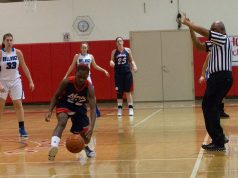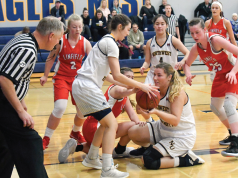As more states and officials’ associations transition to three-person mechanics, lead officials need to become more active and recognize when to rotate ball side.
Gone are the days of lead officials camping out on their side of the floor and calling across the free-throw lane as a trail official leaks to avoid getting beat in transition.
For starters, having a center official means the lead no longer should guess on one-on-one match-ups on the opposite block. An active lead, however, eliminates the need for the center to worry about this match-up — the lead should have rotated to pick up this action and put the crew in the best position to referee the entire play.
“Getting ball side as the lead is the most important thing you can do to assist your crew,” said NCAA Division I men’s basketball referee Kevin Brill. However, knowing when to rotate as the lead is perhaps the toughest aspect of three-person officiating for new officials. Here are some things to consider, whether you are new to three-person or a veteran of the mechanic.
When to go
The ball and the players will dictate rotation. When the ball and post players are on the opposite side, the lead should be in close-down position, ready to rotate once the ball gets close to free-throw line extended.
Getting a feel for what the offensive team is doing also helps the lead in the decision-making process. Paul Patterson, a D-I women’s official and assigner with the Northwest Women’s Intercollegiate Basketball Officials Association, looks first and foremost at whether a team gets its post players involved in the offense.
“If so, then I try to rotate to be in position before the entry pass,” Patterson said. “But if the big isn’t involved or is only used at the high post for screens and passes, but no drives or shots, then I won’t be so anxious to rotate.”
In that case, the lead should not chase the ball as it moves around the perimeter. Instead, be patient and mirror the ball from wide angle to close down — and be ready to pinch the paint on drives down the lane, aware of secondary defenders and prepared to officiate pass-and-crash plays as well as plays at the rim.
To rotate or not to rotate?
That is the question that gets many officials hung up. They hesitate about going across the lane, leaving the crew’s center official having to officiate multiple match-ups with no help.
Brill and Patterson agree that rotating more, especially early in a game, beats not rotating enough.
“We should go into every game with the intention to rotate early and often,” Patterson said. “Then, relax that based on what each team does.”
However, when rotating, remember there are times that a rotation should not take place — or if in progress, the lead should back out and return:
- An immediate shot.
- A drive to the basket.
- A cross-court (skip) pass.
“If the lead rotates during those times, they are putting the crew at a disadvantage,” Brill said. “People won’t know what their responsibilities are to officiate.”
The old rule of thumb was that if the lead was past the center of the basket, he or she should complete the rotation regardless, but as three-person mechanics have evolved, this hard-and-fast rule has disappeared.
Even if the lead is a step from the opposite lane line but has not started to turn to indicate the completion of the rotation, it is better for the lead to back out of the rotation.
“When the lead comes back, the other partners don’t have to switch their eyes and duties as quickly, and the crew will cover the court better versus completing the rotation on shots and drives,” Patterson said.
In the meantime, the lead shouldn’t forget to officiate his or her primary while crossing the lane — only when the lead starts to turn his or her body to cover the new primary should the rotation be considered complete.
This is a great point to discuss in pregame, so the crew is aware of each other’s tendencies.
A great way to keep yourself focused as you rotate is to do a little self-talk, reminding yourself of where you should be looking. Start with the low block you’re vacating, then look toward the high post on that side, followed by the high post on the lane line you’re rotating toward, and finally, as you turn your body to indicate the rotation is complete, the low block in your new primary. By doing this, you ensure that as the crew rotates, it doesn’t miss an illegal screen at the high elbow or a hold by a defender on a flex cut across the end line.
Art vs. science
Most officials agree there is no set rule regarding when to rotate. But there are a few situations that should trigger a rotation more often than not:
- A competitive match-up on the opposite low block with the ball settled on that side of the floor.
- A cross screen to free up an offensive player on the opposite lane line.
- The majority of players, and the ball, on the center’s side of the court.
- A half-court trap set on the center’s side, forcing that official to move up toward the division line to referee the play.
However, a lot of the decision-making involved in a rotation comes from having a good feel for game flow, tendencies and having a sense of where the lead should be to put the crew in the best position to referee play.
Honing that feel to develop an instinctual feel for when to rotate just takes time on the court. The more three-person games you work, the better you’ll become with your rotations.
René Ferrán is a freelance writer and editor who lives in Portland, Ore. He officiates high school basketball and baseball, as well as youth soccer.
What's Your Call? Leave a Comment:
Note: This article is archival in nature. Rules, interpretations, mechanics, philosophies and other information may or may not be correct for the current year.
This article is the copyright of ©Referee Enterprises, Inc., and may not be republished in whole or in part online, in print or in any capacity without expressed written permission from Referee. The article is made available for educational use by individuals.



















